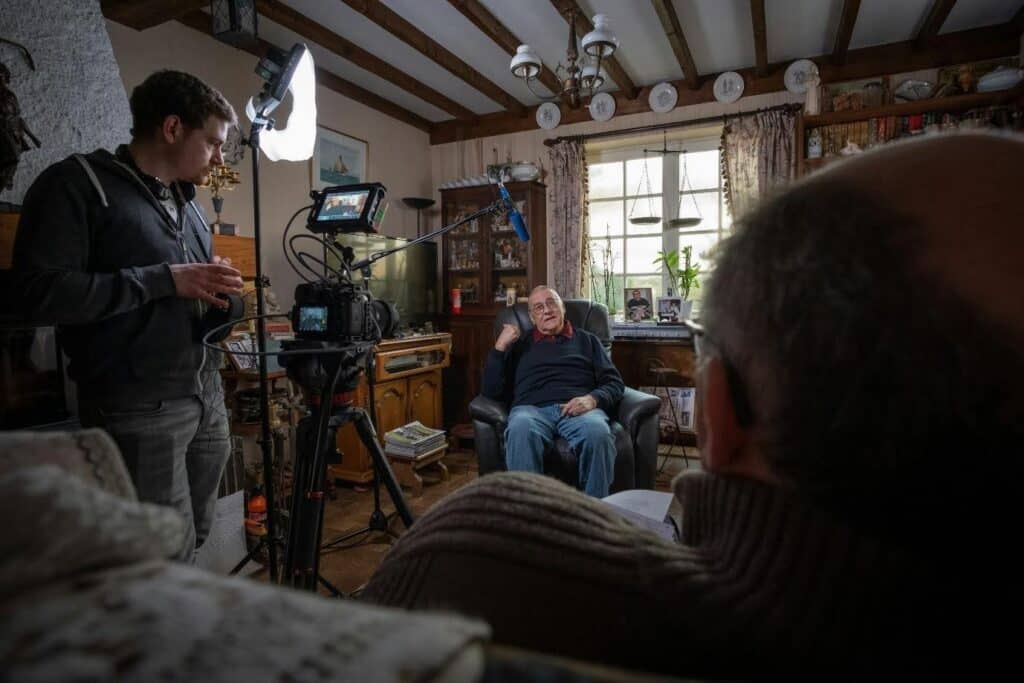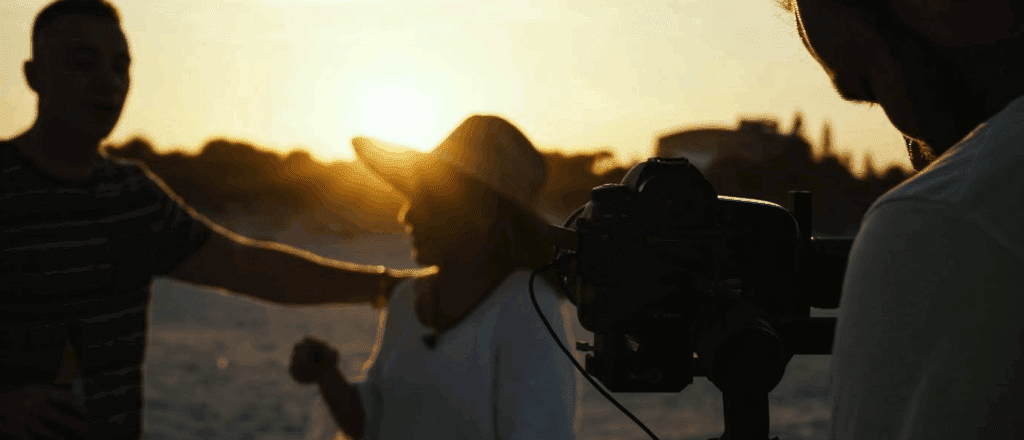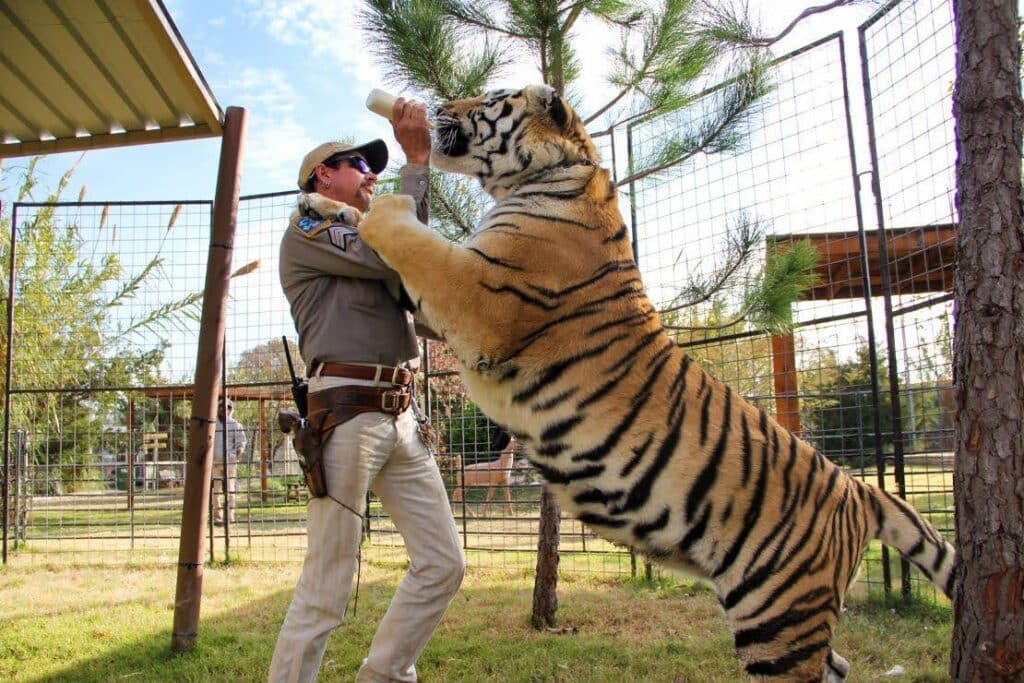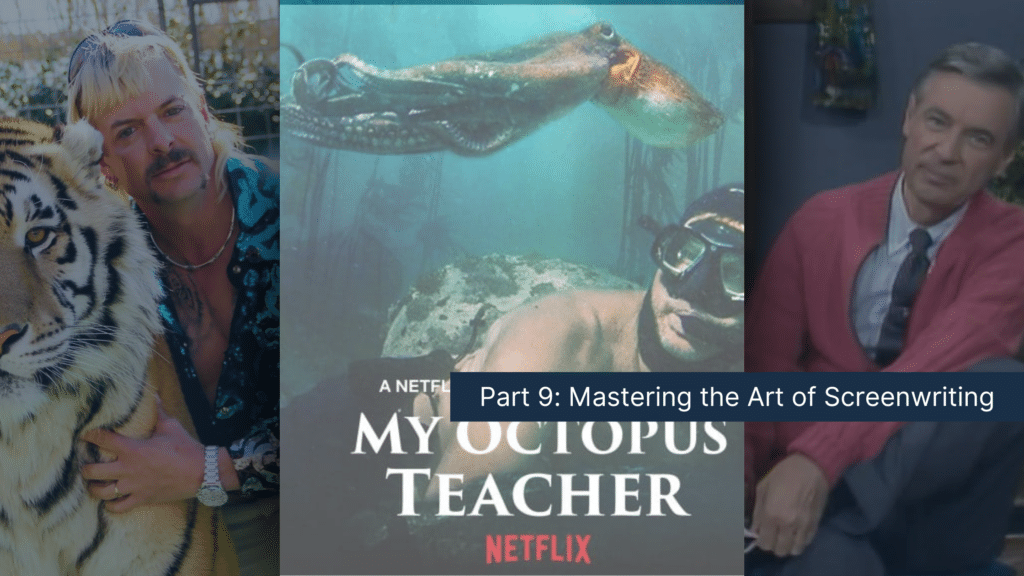
Documentaries have been windows into the wider world for a long time. We are taken away into raw, revealing, and often emotional glimpses into real-life stories, people, and events. Plus, with the consistent rise of streaming services from Netflix to National Geographic, the platform for documentaries has grown exponentially.
Some of us may find ourselves hooked on a gripping true-crime docuseries, others may cozy up in front of a nature film. Or the latest political expose in theaters. No matter your preference, documentaries will always be powerful storytelling tools that educate, provoke, and inspire us.
“In feature films the director is God; in documentary films God is the director.” – Alfred Hitchcock
But what makes documentaries so powerful? How are they crafted? What sets them apart from other visual storytelling forms? Well wonder no more! In today’s blog, we’ll explore the definition of the documentary, it’s characteristics, types and all the behind-the-scenes processes that go into making one.
Let’s get started!

Table of Contents
- What is a Documentary?
- Key Characteristics of Documentaries
- Types of Documentaries
- How Documentaries are Scripted
- Research, Research, Research
- Examples of Impactful Docs & Docuseries
- Tools for Writing and Planning Your Documentary
- FAQ
- Conclusion
What is a Documentary?
A documentary is a nonfictional film or video intended to document reality to primarily educate, instruct, or maintain a historical record.
Unlike fictional films, documentaries aim to present facts, real events, and real people, although the filmmaker’s perspective inevitably influences how the story is told. After all, none of us are immune to a little bias.
The term ‘documentary’ was first coined in the 1920s to describe nonfictional films, but the practice of documenting reality on film dates back to the earliest days of cinema. From early ethnographic films to modern streaming docuseries, the form of the documentary has clearly evolved, yet its central mission hasn’t changed at all. Documentaries will always be here to reveal truth, investigate, and inform their viewers.
Key Characteristics of Documentaries
The beauty of the documentary is that there’s no single formula for how they’re created. Many, of course, will share five core elements. Here they are:
1. Nonfiction Content
Documentaries deal with real people, real events, and real issues. Even if they use re-enactments or dramatizations, the content is always rooted in factual information.
2. Real-Life Footage
Most documentaries will use actual footage. This can include anything from interviews, archival materials, observational videos, and on-locations shoots to tell their stories.

3. Point of View
While documentaries strive for the truth, they aren’t completely objective. The filmmaker’s choices of what to include, what to omit, and how to frame a subject all shape the narrative and message they’re trying to convey.
4. Narrative Structure
Despite being nonfictional pieces, documentaries do often follow a narrative arc consisting of a beginning, middle, and end. Sometimes they will build suspense, present conflict, and end on a resolution much like their fictional cousin.
“In documentary films, you’re a storyteller using found objects. You still have to have a story arc and all the elements that make a good story. It really helped me mature as a storyteller.” – Garth Stein
5. Purpose-Driven
Documentaries usually have a clear purpose to inform, persuade, entertain, or spark action. Whether it’s advocating for social justice or exploring a scientific topic, documentaries often aim to leave a lasting impact.
Starting your own doc? Celtx helps you structure your story before the camera roll.
Click here to sign up
Types of Documentaries
Over the course of filmmaking history, documentary makers and scholars have identified different styles or ‘modes’ of documentary. While many films combine elements of several of these ‘modes’, here are some of the most common types:
Observational
Also known as ‘direct cinema’, the observational documentary style avoids narration or interviews and simply observes events as they unfold, with minimal interference. The audience is a fly-on-the-wall!Primary (1960) is a great example of the observational documentary, following John F. Kennedy during his primary presidential campaign.
Participatory
In participatory documentaries, the filmmaker integrates into the story and becomes a part of it. They often appear on screen, interacting with subjects and shaping the events they’re covering. Think Super Size Me (2004) where Morgan Spurlock documents his own experience eating McDonald’s meals for 30 days.
Expository
This is a traditional documentary format that features narration, interviews, and visuals designed to support a clearly argued thesis or point.David Attenborough provided voiceover and perspective in The Blue Planet (2001) series for the BBC.
Reflexive
Reflexive documentaries turn the camera on themselves, examining the actual filmmaking process or questioning the truthfulness of documentaries. It’s all very Inception, isn’t it?
Man with a Movie Camera (1929) is one such example, made by Dziga Vertov.
Poetic
Poetic documentaries are more of an experimental style, using imagery, tone, and rhythm more than structured narrative. It’s more about evoking emotions than delivering facts.
Just like Koyaanisqatsi (1982) which uses music and visuals to comment on modern life.
“In documentary films, being able to be a storytelling and embrace film as an art form – while being very clearly connected in trying to help make the world a better place – is really important to me.” – James Redford
Performative
Blending personal experience with broader themes, these documentaries often highlight subjective truths, such a race, gender, or identity. Think Tongues United (1989) by Marlon Riggs.
How Documentaries are Scripted
Okay, but are documentaries actually scripted? Well, unlike fictional films that begin with a complete screenplay, documentaries will often evolve organically. Still, scripting plays a role, just in different phases.
Pre-Production Planning
Before shooting, a treatment or outline is typically written, outlining the subject, possible interviews, locations, and structure. At this point, the ‘script’ is more like a roadmap than a locked screenplay.
During a Production
Filmmakers may restructure or revise the plan as new developments unfold. Documentaries will often take unexpected turns based on new findings, changing circumstances, or interview revelations.

Post-Production Scripting
Believe it or not, a script can emerge in the editing room and determine a documentary’s final narrative. It’s here where it’s decided which final clips are used, how they’re sequenced, and whether voice-over narration or titles are added. Editors may work with a post-script to guide pacing, structure, and tone.
So, while documentaries may not always start with a detailed script (like their fictional counterparts), storytelling still very much matters, a lot of it coming together in post-production.
Real stories need real planning.
Use Celtx scriptwriting software to shape your documentary from script to screen.
Get started today (it’s free)!
Research, Research, Research
Documentary filmmaking is deeply tied to journalistic and academic research. Good research makes sure the story is accurate, credible, and ethically presented.
There are several phases when it comes to researching for a documentary:
- Preliminary research includes background reading, identifying key figures, understanding the history of the topic, and crucial fact-checking.
- Next is interview prep where the filmmaker determines what and whom to ask, requiring research into their subjects’ lives and expertise.

- During the documentary-making process, there will always be ongoing investigation, working on new leads, findings and data. Sometimes these can completely reshape the story mid-production.
- Throughout, there will also be extensive archival research, including footage, photographs, news reports, and public records to add historical context and evidence.
Research for any documentary must be thorough as it underpins both compelling and truthful storytelling as well as protects filmmakers from legal or ethical issues.
And if you want to explore research some more, check out our 10 Must-Know Tips for Researching Your Screenplay.
Examples of Impactful Docs & Docuseries
Of course, not all documentaries are made the same! So many have left lasting impressions on culture, policy, and storytelling. Many haven’t.
However, here at Celtx, we’ve collated five of the very best documentaries and docuseries of recent years you should watch!
13th (2016) | Ava DuVarney
This documentary explores the racial inequality in the US prison system, connecting the dots from slavery to mass incarceration.
My Octopus Teacher (2020) | Craig Foster
A stunning and personal journey into the connection between a man and a wild octopus. It truly showcases the power of nature and relationships between humanity and the natural world.
Making a Murderer (2015) | Laura Ricciardi and Moira Demos
A true-crime docuseries that captivated audiences worldwide as well as sparking widespread debates about the US legal system.
The Act of Killing (2012) | Joshua Oppenheimer
A surreal yet chilling exploration of war crimes in Indonesia, where perpetrators reenact their acts for the camera.
Won’t You Be My Neighbor? (2018) | Morgan Neville
A heartfelt tribute documentary to Fred Rogers that explores kindness, childhood, and compassion through documentary form.
We can learn so much from documentaries like these, but there’s more to explore! Did you know PBS offer free discussion guides, lesson plans, reading lists, and other resources inspired by their own documentaries?
You can find them all right here.
Tools for Writing and Planning Your Documentary
Planning and then writing a documentary is both a creative and logistical process. It can seem like a bit of a minefield, however fear not!
Thanks to the wonders of technology and smart thinking, there are many tools and methods filmmakers use to build their stories. Here are some of our top picks:
1. Storyboarding
While documentaries don’t follow strict shot lists, creating storyboards or visual outlines can help plan your sequences or visual metaphors.
Celtx’s integrated storyboarding tools are perfect for planning out your documentary. Simply upload your own images or drag and drop using our pre-loaded images. Find out more here.
2. Treatment Writing
A treatment is a summary of your documentary’s purpose, subject and proposed structure written in prose. It’s often used for pitching or grant applications.
Need some advice on how to write a killer treatment? Check out our complete guide on How to Write a Film Treatment.
3. Interview Planning
Developing interview outlines, release forms, and question sets makes sure you’re prepared and respectful to your subjects.
4. Research Databases
It can be tricky to know how to organize all the extensive research you’ll be conducting for your film. Tools like Zotero, Evernote, or even Google Docs can help organize research, source materials, and citations.
5. Editing Software
Programs like Adobe Premiere Pro, Final Cut Pro, or DaVinci Resolve allow filmmakers to weave footage, narration, and sound into a cohesive whole.
6. Scriptwriting Tools
Even for partial scripting, apps like Celtx are here to help you write voiceover scripts or plan narrative segments. Plus, with Celtx, you can integrate your script and storyboard making the transfer of ideas and communication with your entire crew smooth and efficient.
FAQ
What’s the difference between a feature documentary and a short documentary?
A feature documentary is typically 60-120 minutes in length, often screened in theaters or at film festivals. On the other hand, short documentaries are usually under 40 minutes, and are often produced for online platforms, educational purposes, or as part of a series.
Both can be as impactful as each other, though features offer more space for complex storytelling.
What is a docuseries?
A docuseries is a multiple-episode documentary, often structured like a television season. Each episode may cover a specific aspect of the story or explore a related theme. Think The Last Dance, Tiger King, or Wild Wild Country.
Docuseries usually allow for deeper dives into complex stories and characters that wouldn’t fit into a single film.

Conclusion
Documentaries are more than just nonfiction films. They’re powerful vehicles for truth, empathy, and change. Whether observational or performative, scripted or spontaneous, short or serialized, they capture slices of reality that might otherwise go unnoticed.
Understanding how documentaries are made, from research and planning to shooting and editing, reveals just how much intention goes into every frame. As a viewer or aspiring filmmaker, appreciating the craft behind documentaries helps you see the world through a sharper, more thoughtful lens.
So, the next time you watch a documentary, remember that behind that compelling story is a team of storytellers working tirelessly to bring truth to light.
Up Next:

How to Write a Documentary Script: A Step-by-Step Guide
Ready to start writing your own? Learn how to shape real stories into structured, compelling narratives with this guide!
